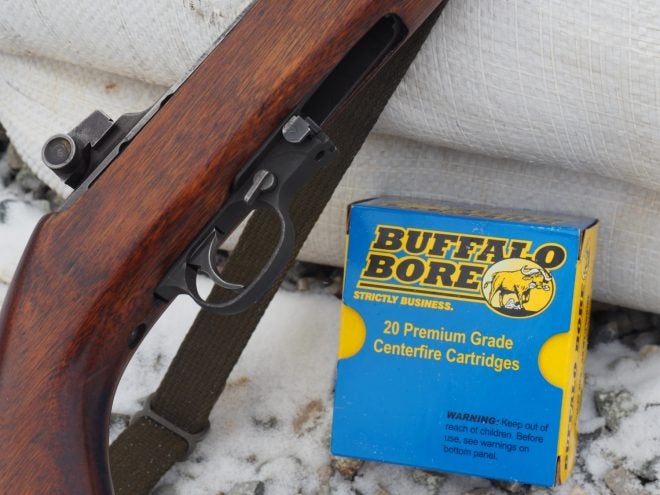Feeding a Classic
There are millions of United States Carbine, .30, M1 Carbines out there. There’s a lot more to these light, handy, and once-affordable carbines than one might think if one hasn’t handled them before. Despite their oft-repeated combat ineffectiveness, they make a well balanced and light home defense carbine. I personally know someone who uses the M1 as their carbine of choice for such a purpose. My personal version is a papered, 1943-dated carbine of General Motors manufacture. While I enjoy taking it to the range, the .30 Carbine ammunition that I’ve been able to get for it has been somewhat low-powered. I’ve often wondered if I had to use this carbine for defensive purposes, what would be available as quality ammunition for such a purpose?
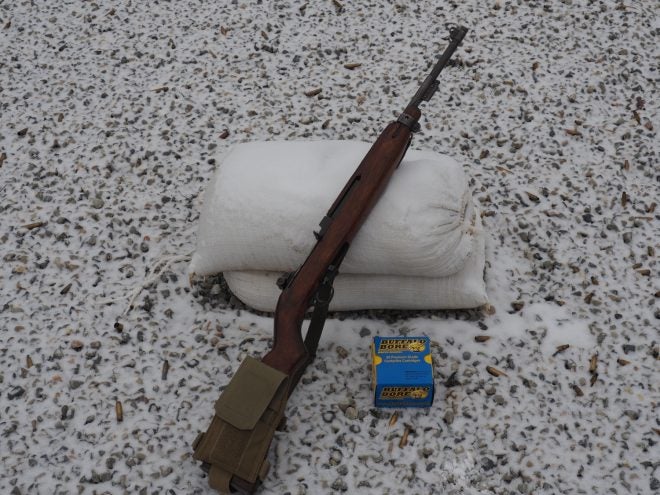
It may be old, but it’s still viable…
More power
When looking for higher-powered ammo, usually Buffalo Bore is one of the first places I check. As a customer, I appreciate their posted velocities being tested out of standard length barrels. I also have verified many of their velocities from various calibers and they are always true to the claim, unlike some other manufacturers. Buffalo Bore did indeed have some “Full Power+ 30 M1 Carbine” loads, moving at 2100 fps. I decided to try a few boxes to see if it performed as claimed. BB (Buffalo Bore) has FMJ, Soft Point, and JHP loads in 110 grain, but only the FMJ and SP loads were available at the time I ordered them. Most of these rounds run $28.79 for a box of 20. While more expensive than the average of 30-40 cents per plinking round, they offer a different level of capability.
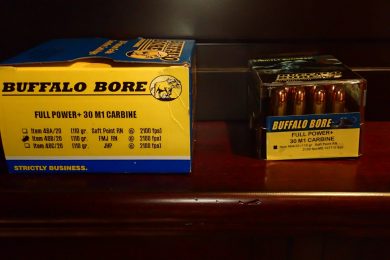
Left: Old style packaging with FMJ
Right: New Packaging with SPRN

Newer hard plastic packaging from Buffalo Bore
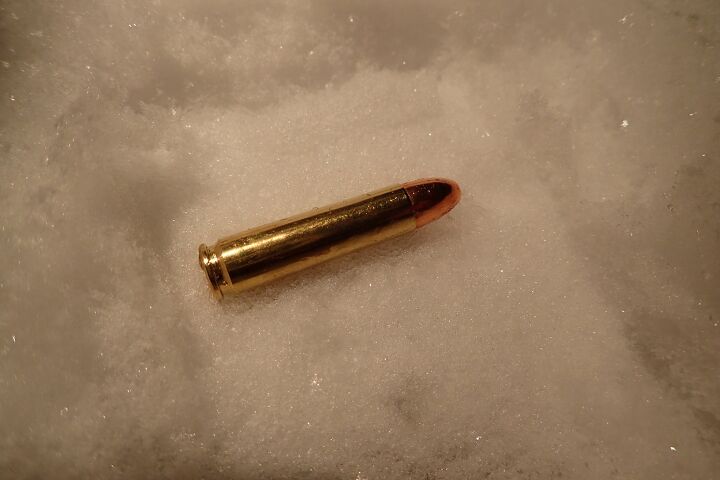
Full Power+ FMJ
Cold, Hard Data:
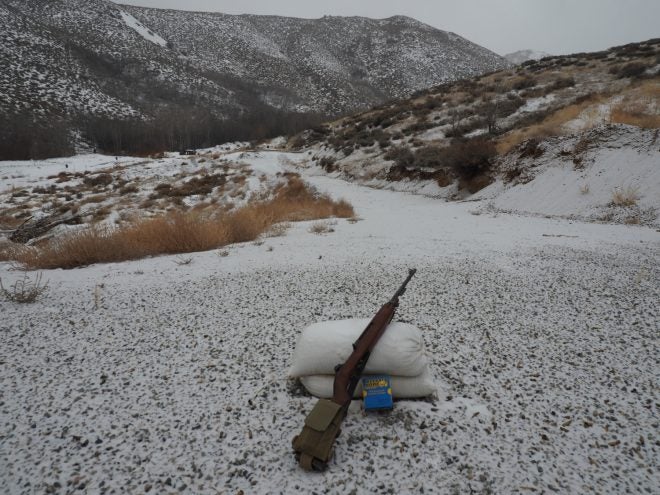
Cold-bore shot? No problem!
Once I received the ammunition, I went to the range with my Carbine, a Magnetospeed V3 Chronograph, the BB Full Power+ ammo and some Remington UMC for comparison. Temperatures were in the high teens and low 20’s for the duration of my testing. Note: This is not as in-depth an ammunition test as Andrew’s gelatin tests. I do not have a good setup for gelatin testing. Testing was done prone, off a front rest. First off was the Remington UMC 110gr FMJ that I use for plinking with this carbine. I obtained the following data:
Remington UMC .30 Carbine 110gr, velocity in fps:
- Max: 1936
- Min: 1885
- Avg: 1906
- ME: 850 ft/lbs
- Energy@ 100Y: 587 ft/lbs
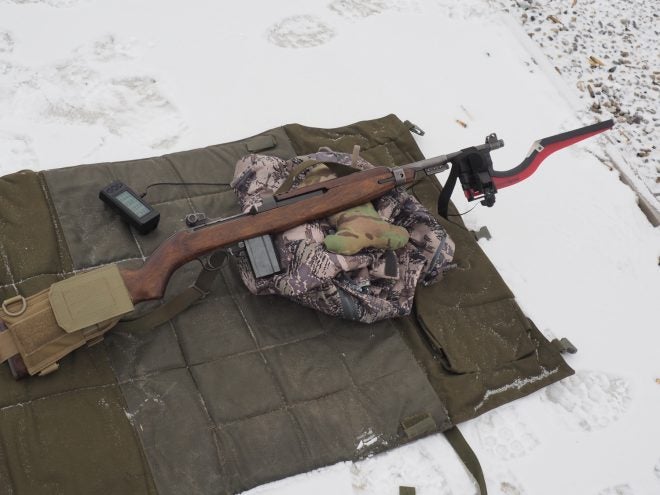
Definitely not the bayonet the carbine’s designer envisioned
I then switched over to the Buffalo Bore FMJ load. Right away, I noted that recoil was a bit more pronounced. Cartridge ejection also varied greatly from the Remington ammo. The Remington cases ejected to my 3-4 o’clock position, while the BB cases ejected to my 1 o’clock (and quite a bit farther). There were no malfunctions with this ammunition using the 15-round surplus magazine. The BB load yielded the following data:
Buffalo Bore Full Power+ 30 M1 Carbine 110gr FMJ, velocity in fps:
- Max: 2128
- Min: 2087
- Avg: 2110
- ME: 1082 ft/lbs
- Energy @ 100y: 740 Ft/lbs
This average velocity is extremely close to, though a bit more, than Buffalo Bore’s stated velocity of 2100fps. Once again, I have always found them to be truthful about their velocities.
A note on accuracy:
While groups at 100 yards were a bit tighter with the BB ammo than with the Remington ammo, this is a pretty old carbine. Although its bore and rifling are in pretty good condition given its use and age, surplus M1 Carbines are known to on average produce 3-4 MOA groups, depending on barrel band and recoil plate fit. Both groups fired were within this average, and nothing to write home about.
Calculating conclusions:
There are other options for defensive .30 carbine ammunition out there. Hornady makes a FTX version in their critical defense line, and IWI .30 carbine SP ammo is also available. These two loads do not approach the BB ammo in terms of velocity and energy, however. Only the Underwood/Lehigh 85gr “extreme cavitation” round approaches the velocity of the BB round, but does not match the muzzle energy. To put the BB load’s muzzle energy in perspective, 1082 ft/lbs is roughly comparable to a Federal .357 Magnum 158gr JHP out of a similar length barrel.
The Buffalo Bore ammo proved it was more powerful than the standard M1 Carbine ammo. In fact, the Full Power+ ammo has as much energy at 65y as the Remington UMC ammo had at the muzzle. If one uses the M1 Carbine as a defensive arm, one would be much better served by the BB ammo for such purposes. I would recommend the use of the SP or FMJ rounds if one can find them. Though pricier than standard plinking ammo, it is always wise to use the best rounds available for one’s purpose. If one is looking for a good defensive round for the .30 carbine, take a look at Buffalo Bore. It’d be a great load for one’s Magal, Automag III, Cristóbal, Franchi LF-58, Kimball (take a look at this gem), or for the good old United States Carbine.

Buffalo Bore’s .30 Carbine Soft Point Round Nose Ammo
For more information, please visit Buffalo Bore.
 Your Privacy Choices
Your Privacy Choices
